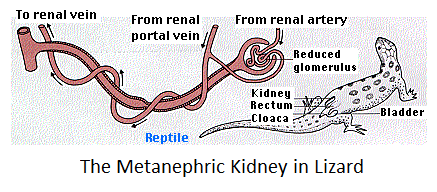
Kidney of adult reptile is
A. Metanephric
B. Mesonephric
C. Pronephric
D. All of the above
Answer
551.4k+ views
Hint: Kidneys are bean-shaped organs that are present in pairs in the lower abdominal cavities of reptiles, mammals, birds, etc. Reptiles are animals having four limbs on which they crawl and hence are called tetrapods. They have well-developed glomeruli in their kidney.
Complete answer: Reptiles are tetrapod vertebrate animals that include turtles, crocodiles, lizards, etc. Reptiles perform excretion through small kidneys. Their main excretory product is uric acid. The reptile kidneys are not able to produce liquid urine thus they excrete in more concentrated forms. This is due to the lack of loop of Henle in their kidneys.

The reptiles have metanephric kidneys. This means that they have well-developed glomerulus in their kidneys. The glomerulus is the network of filtering vessels. Such types of kidneys are seen in birds and mammals also. In reptiles, the metanephric kidneys lie in a more caudal position in the body cavity. Also, they have much larger kidneys with a compact structure containing many tubules. The kidney drains in the ureter. Some reptiles are able to reabsorb stored water in the bladder. The mesonephric kidney is that which has an internal glomerulus enclosed in a capsule-like structure. This forms the Malpighian bodies. Such types of kidneys are present in adult fishes and amphibians. The pronephric kidneys are found in jawless fishes. These kidneys represent the earliest stage of development.
Thus, from the above discussion, we can conclude that option A is correct.
Note: The urinogenital ducts and the anus are the draining organs of the excretory system of reptiles. They both empty their excretory products in the cloaca. Also, reptiles like tortoises, turtles, and lizards have very large bladders.
Complete answer: Reptiles are tetrapod vertebrate animals that include turtles, crocodiles, lizards, etc. Reptiles perform excretion through small kidneys. Their main excretory product is uric acid. The reptile kidneys are not able to produce liquid urine thus they excrete in more concentrated forms. This is due to the lack of loop of Henle in their kidneys.

The reptiles have metanephric kidneys. This means that they have well-developed glomerulus in their kidneys. The glomerulus is the network of filtering vessels. Such types of kidneys are seen in birds and mammals also. In reptiles, the metanephric kidneys lie in a more caudal position in the body cavity. Also, they have much larger kidneys with a compact structure containing many tubules. The kidney drains in the ureter. Some reptiles are able to reabsorb stored water in the bladder. The mesonephric kidney is that which has an internal glomerulus enclosed in a capsule-like structure. This forms the Malpighian bodies. Such types of kidneys are present in adult fishes and amphibians. The pronephric kidneys are found in jawless fishes. These kidneys represent the earliest stage of development.
Thus, from the above discussion, we can conclude that option A is correct.
Note: The urinogenital ducts and the anus are the draining organs of the excretory system of reptiles. They both empty their excretory products in the cloaca. Also, reptiles like tortoises, turtles, and lizards have very large bladders.
Recently Updated Pages
Why are manures considered better than fertilizers class 11 biology CBSE

Find the coordinates of the midpoint of the line segment class 11 maths CBSE

Distinguish between static friction limiting friction class 11 physics CBSE

The Chairman of the constituent Assembly was A Jawaharlal class 11 social science CBSE

The first National Commission on Labour NCL submitted class 11 social science CBSE

Number of all subshell of n + l 7 is A 4 B 5 C 6 D class 11 chemistry CBSE

Trending doubts
What is meant by exothermic and endothermic reactions class 11 chemistry CBSE

10 examples of friction in our daily life

One Metric ton is equal to kg A 10000 B 1000 C 100 class 11 physics CBSE

1 Quintal is equal to a 110 kg b 10 kg c 100kg d 1000 class 11 physics CBSE

Difference Between Prokaryotic Cells and Eukaryotic Cells

What are Quantum numbers Explain the quantum number class 11 chemistry CBSE




